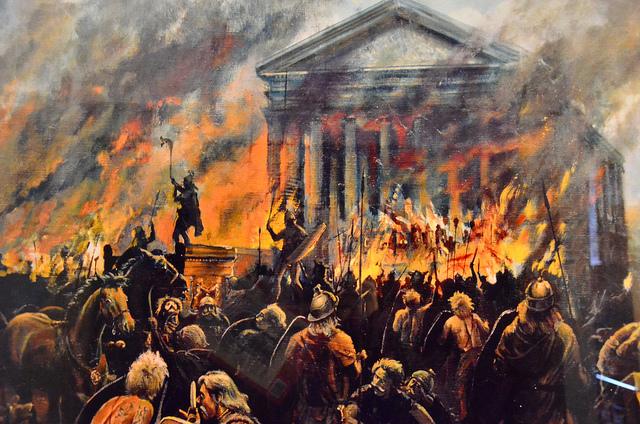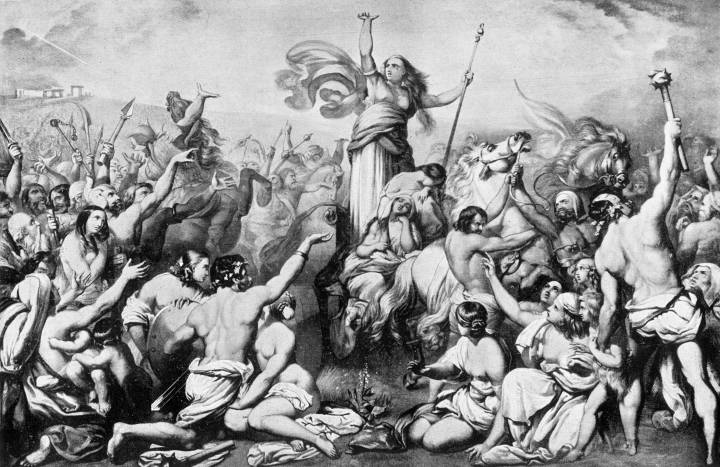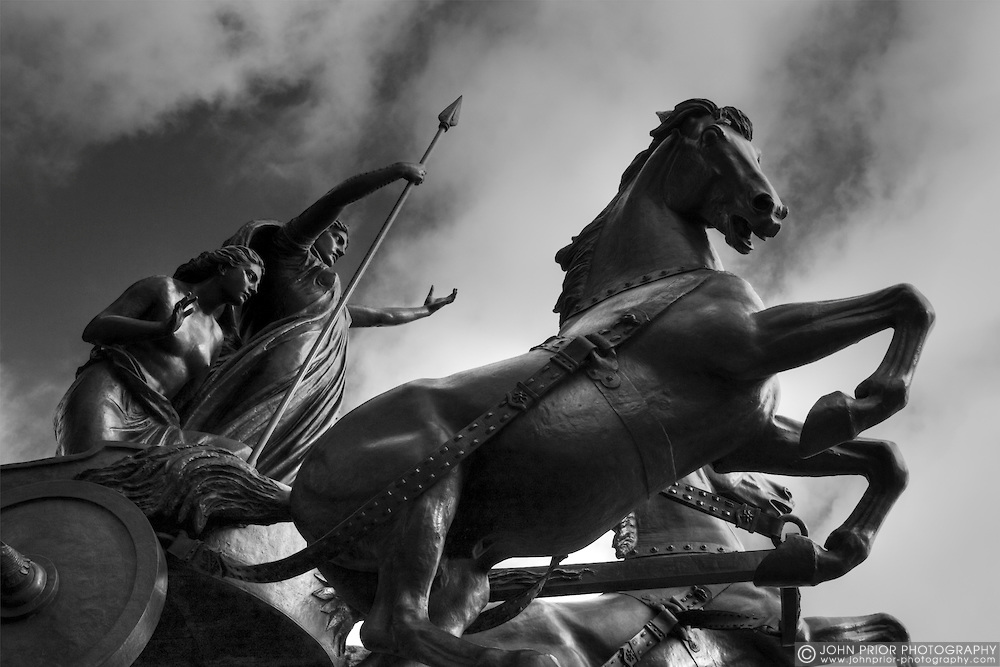“Nothing is safe from Roman pride and arrogance. They will deface the sacred and will deflower our virgins. Win the battle or perish, that is what I, a woman, will do.” – Boudica, Queen of the Iceni.
![Alex Kingston as Boudica in the film "Warrior Queen" [PHOTO: pinterest]](https://historythings.com/wp-content/uploads/2017/01/6799b6a68d712555f4dcc75c53b0b164.jpg)
Alex Kingston as Boudica in the film Warrior Queen [PHOTO: pinterest]
Last time on History’s Badasses, we covered the incredible life of the Thracian, Spartacus, the Roman slave who led a rebellion numbering over 90,000 men, defeated Roman generals in battle, and almost won his freedom. We’re staying close to that period of history this time, jumping just ten years earlier to AD 61. This time, we’re talking about the badass queen of the Iceni, Boudica, who led her own rebellion against Rome and very nearly won.
Boudica (also spelled Boudicca or Boadicea) slaughtered an entire Roman army, put London to fire and sword (and the effects of it can actually be read in the archaeological record), and killed over 70,000 civilians across the Roman cities of Londinium (modern-day London), Verulamium, and Camulodunum. She would not stand to be under Roman rule. She wanted to live free from tyranny, and she wanted that for the rest of the Celtic people in ancient Britain, too. But what sent her on such a rampage? Why did she lead such a bloody rebellion? Why didn’t she succeed?
Historical Background
Not much is known about Boudica’s early life. All we know about her from historians was that she was born around AD 25. She was from a royal, influential family in Celtic Britain, and married her husband, Prasutagus, when she was eighteen. Together they became the elected rulers of the Iceni tribe in Britain. According to Roman writers, she had druidic training, flaming red hair, and two daughters who were born sometime after the Roman conquest of Britain in AD 43, probably when Boudica was in her early twenties.
The Celts and the Romans weren’t always at odds, and they weren’t for the first part of Boudica’s lifetime. A hundred years earlier, when the Romans had first set foot on British soil, the Celts had welcomed them with open arms. The Iceni, Boudica’s own tribe, had loyal allegiance to the Roman Empire and traded with Rome, growing rich off of their profits.
![The territory of Britain controlled by the Iceni. [PHOTO: wikimedia]](https://historythings.com/wp-content/uploads/2017/01/744px-Map_of_the_Territory_of_the_Iceni.svg_-724x1024.png)
The territory of Britain controlled by the Iceni. [PHOTO: wikimedia]
But then Rome had to get greedy…
In AD 41, Emperor Claudius became Caesar. He decided to annex Britannia in order to take over its source of grain and iron. Beyond that, Claudius had been born with a limp and a stutter, and there were many people in Rome who thought him weak. To combat that, he decided to start a war with the Celtic tribes to prove he wasn’t.
Boudica was eighteen when Claudius invaded Rome. Most of the Celts expected the Romans would eventually leave…but then they didn’t. Emperor Claudius stationed troops at Camulodunum and made it very clear he wasn’t leaving. He drove the native Celts off their lands with threats of execution and torture. For a time, the Iceni submitted.
However, in AD 54, the Roman rule changed hands. Nero poisoned Claudius and took the name of Caesar. He elevated his uncle to god-status, built a temple for him at Camulodunum and bid the British to worship him. He pressed them to finance the building the temple and pressed them to pay taxes to Rome.
In AD 58, Nero appointed a new governor to Britain: Caius Seutonius Paullinus, an aggressive general who launched a military campaign on Wales. He attacked Druidic strongholds, burned Druids at the stake, and cut down sacred Druidic groves.
Humiliation and Defeat
![Nero. [PHOTO: history.com]](https://historythings.com/wp-content/uploads/2017/01/122227072-H-1024x335.jpeg)
Nero. [PHOTO: history.com]
It was during this time, as Boudica watched everything she knew going up in flames, she lost her husband, too. Prasutagus fought at the battle of Mona, a Druidic stronghold, and was killed. With Prasutagus, leader of the Iceni, dead, the Romans swooped in on Iceni lands, claiming them as property of Rome.
Boudica, now the elected leader of the Iceni tribe said, “um, excuse you”, and demanded an audience with the Roman military guard and procurator, Decianus Catus to try and work out a diplomatic deal.
The trouble was the Romans were extremely misogynistic and didn’t recognize Boudica as the leader of the Iceni. They didn’t give her any respect at all. Instead, angered at the impertinence of a woman to question the power of the Roman Empire, the Roman officials flogged her and ordered that both of her daughters be raped by the Roman military guard.
Well, enough was enough. Boudica was done with diplomacy and done with submitting.
The Celtic Rebellion

PHOTO: Tumblr.com
Boudica donned a torc (the Celtic equivalent of donning a crown), gave an angry speech, and sent messengers out to every Celtic tribe in the area, telling them that Roman rule had gone on long enough.
The rest of the tribes more than agreed. They had secretly been stockpiling weapons against Rome and were ready for war. They joined up with Boudica and Boudica launched her rebellion.
She decided to strike Camulodunum first, home of that hateful temple that Nero had constructed. Boudica wanted to make a statement. She rigged the statue Nero had erected of his uncle, Claudius, to fall down to the earth in fire and smoke without explanation, as if the gods had sent it tumbling. Then, she sent women in to chant deliriously, predicting the doom of the city. It worked. The Romans fell into a terror and begged for military assistance from London.
Catus Decianus didn’t think much of it and sent only 200 soldiers to reinforce the town’s small garrison. The Romans hadn’t built a wall around the city. In their arrogance, they didn’t even bother to evacuate the women, children, and elderly.

PHOTO: thebiritshhistorypodcast.com
Boudica waited for the settlers to fall into a terror and the soldiers to puff themselves up in arrogance and then she swooped in. Her army overran the town, tore down the temple that Nero had built for his uncle, and smashed the entire town to the ground. In fact, archaeological records show that Boudica set the entire city to flame and the fire was so hot that it fired some of the buildings’ clay walls as if they had been in a pottery kiln.
Boudica went on to ambush and slaughter 2,000 Roman legionaries and 500 Roman cavalry. When more reinforcements came out to support the Romans in the area, Boudica butchered them, too. She burned a path all the way to Londinium, dead set on purging the Romans from Britain for good.
Even the Roman governor, Seutonius, could do nothing to stop her. He decided to sacrifice Londonium in an attempt to save Britannia from the rebellion. When Boudica got there, she was met no resistance. She killed everyone in the city, strung the Roman nobles naked in the city streets, impaled the Roman women on stakes outside the town, and torched the entire city.
After that, another Roman city, Verulamium fell to Boudica’s wrath, too.
Death and Legacy

PHOTO: photoshelter.com
By then, Seutonius had amassed some-odd 10,000 troops. Boudica’s forces still outnumbered his twenty to one. Where, exactly, these two forces met for their final battle is unclear, but it was an open field, and that was Boudica’s first mistake.
Previously, she had been attacking the Romans in their own cities or in forests, using guerrilla warfare tactics that the Celts were highly skilled at. The Roman army wasn’t built for guerrilla warfare and as long as the Celts stuck to their own tactics, they were winning. The Celts were no match for the Romans in open combat, but they had become so over-confident that, for this final battle, they even brought their wives and children with them in wagons to watch their victory.
Boudica herself had donned her battle armor and warpaint and rode in a chariot with her daughters in front of her. She approached each tribe lined up on the field separately, shouting encouragement at them, preparing them for the battle to come. The Celts hurled insults and threats at the Roman soldiers opposite them, trying to terrify them before they even crossed swords.
Seutonius, on the other side of the field, told his soldiers to pay little attention to the Celts’ vast numbers and threats. They were poorly armed and undisciplined, he said, and discipline would win the war. He had stationed his troops in a valley opposite Boudica’s open field, and he was confident he had this in the bag.
When both generals had given their speeches, Boudica ordered her charge. What ensued was a disaster for the Celtic army.
The Celts met the Romans in their valley, and the Romans managed to bottleneck the Celtic warriors through the natural feature, stabbing them with javelins and short swords, hiding behind their massive shields.
The Celtic army wasn’t prepared for this form of warfare, and they racked up an enormous 80,000 casualties. It was a crushing blow to their rebellion. Seutonius ordered his soldiers to step over the pile of Celtic bodies and pour out into the field. He trapped the enemy forces between his own Roman soldiers and their wagons and slaughtered them all, including the women and children.
Boudica, it’s said, killed herself on the battlefield after witnessing the death of her two daughters. She was mourned throughout Britain for years.
After the defeat of the Celtic rebellion, the Romans swooped in and tightened their control on Britannia, but Boudica’s death was not in vain. Even though the Celts had lost, they’d won something with the Roman Empire: respect.
After Boudica’s rebellion, the Romans decided to treat the Celts in Britain with justice and honor, and because of that, Britain flourished.
Boudica captivated Roman writers and historians who were fascinated by the idea of a woman who could take on an empire. She was the only person in history to unite the Celtic tribes against a common enemy. She was a warrior, queen, mother, and unparalleled badass, and even though she lost, it’s worth noting that, had she not become overconfident, she probably would have succeeded in pushing the Romans out of Britain. If she had, the England we know today would look very different.

